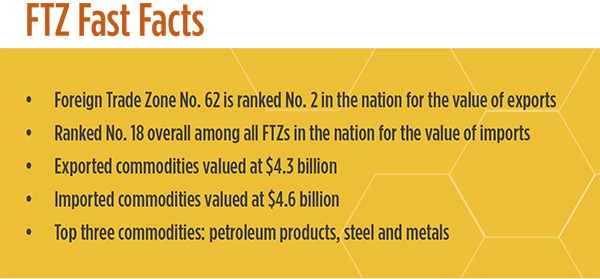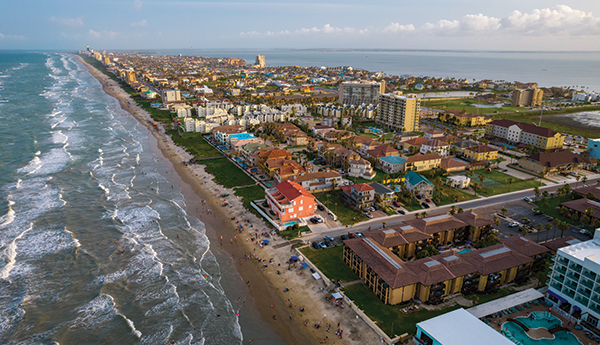Cameron County, the southernmost county in Texas, is a historically significant international crossroads. Located in the Rio Grande Valley, the county’s unique economic and cultural mosaic is attracting people and businesses to the region.
Home to approximately 424,000 people, Cameron County includes the cities of Brownsville and Harlingen and popular tourism destinations, including San Padre Island and Port Isabel. The Rio Grande Valley offers a unique and unsurpassed quality of living with year-round warm temperatures, stunning natural geography complete with beaches, riverfront and resacas (ancient channels carved by the Rio Grande), top-notch institutions of higher education and an exceptionally low cost of living, too. The county’s cost of living index is 72.5, compared to the U.S. average of 100.
As part of the four-county Rio Grande Valley, Cameron County is poised for explosive growth. According to census data, the Rio Grande Valley region is larger than 15 other U.S. states and territories and is expected to grow according to population estimates.
Boasting three higher education institutions — the University of Texas Rio Grande Valley, Texas Southmost College and Texas State Technical College — Cameron County also offers ample opportunities for students to advance their skills and training.
In addition to offering its residents a high quality of life, Cameron County’s business climate is thriving.
The Brownsville Borderplex region is home to various industries, including advanced manufacturing, heavy manufacturing, aerospace, automotive, medical, retail, aviation, international logistics and food processing. In addition, several industries maintain a strong foothold in Harlingen, including health and biotechnology, automotive and industrial supply, logistics and aerospace. South Padre Island’s miles of pristine shoreline, tropical scenery, wildlife and exciting attractions lure thousands of tourists to the county every year.
While mainstay industries are continuing to grow in the county, several high-profile, innovative companies, including SpaceX, Paragon, and others, have chosen to establish a base of operations in the county.
Mark Yates, Director of Economic Development and Community Affairs in Cameron County, said the region’s sky-high growth is inevitable as high-tech industries continue to expand throughout the county and the state. As a life-long resident, that’s something he likes to see and is actively working to attract.
“People are starting to find out about us, but we want the rest of the world to know what we have here. There’s a lot going on here,” Yates said. “We’re a low-tax environment, and we have no state income tax. We have plenty of land for development. When we have an industry that wants to move here, we rally the universities and the workforce board to make sure we can respond to the needs of that industry. We have a few incentives for business, including our Opportunity Zones, the Foreign Trade Zone, the Freeport Tax exemptions. We have qualifying tax abatement incentives and Tax Increment Financing Zones, too.”
Small businesses are well-supported in Cameron County. The county’s Certified Development Coproration is working with local lending institutions to provide Small Business Administration loans. Yates said the county understands small businesses are the key to creating jobs and spurring economic growth in the county and broader region. “Our vision is that access to capital is the greatest barrier to small business start-up and sustainability,” he explained.
International Connections
With “front door” access to Mexico, two commercial airports and a deepwater port in the Gulf of Mexico, the region offers a cadre of logistical advantages. Five international bridges cross into Mexico and offer dedicated commercial lanes that provide convenient access to Foreign Trade Zone 62, anchored at the Port of Brownsville. FTZ 62 is consistently ranked among the top three U.S. FTZs for exports. With 2,300 acres available, it is also one of the largest in the country and the largest in the state.
Across the border, Matamoros, Tamaulipas, is a thriving manufacturing hub in Northern Mexico. The region is home to a cluster of 50 automotive companies and 150 manufacturing plants. This proximity makes Cameron County a central link in the supply-chain-logistics of the North America “Auto Alley.”
Additionally, the population in the Brownsville/Matamoros metropolitan region is over 800,000. Ramiro Aleman, Director of Business Recruitment, Retention and Expansion for the Greater Brownsville Incentives Corporation, said Brownsville and the Rio Grande Valley have always maintained strong economic and cultural ties with Mexico.

“Mexican shoppers cross the border daily to shop and visit our tourist attractions like the Gladys Porter Zoo, Brownsville Farmer’s Market and even events like the world-renowned Charro Days Festival, a binational celebration of cultural and economic ties,” said Aleman. “Also, there are several companies, mainly in the automotive sector that practice the “twin plant” system in which corporations have operations on both sides of the U.S.-Mexico border. This has long been a main economic driver in the area and continues to this day.”
Reaching Global Markets
Cameron County Judge Eddie Treviño, Jr. said the Port of Brownsville is one of the biggest economic engines in Cameron County, highlighting the port’s limitless potential as one of the few that still have plenty of space for companies to grow into. Currently home to 273 companies, including the largest steel movers in the county, the Port is responsible for over 51,000 jobs in the region and $3 billion in annual state economic activity.
The Port of Brownsville is the only deepwater port located on the U.S. Mexico border and handles a variety of cargo products, including steel, liquid, breakbulk and dry bulk commodities. In addition, the port has approximately 40,000 acres of land available for development and 17 miles of waterfront access, providing direct access to non-congested international bridge crossings and rail connections.
The Port of Brownsville is currently deepening the port’s ship channel from its current 42-foot draft to 52 feet. When complete, the Port of Brownsville will become one of the deepest ports on the Gulf of Mexico and will be able to accommodate larger vessels.
Additionally, the Cameron County Regional Mobility Authority (CCRMA) is beginning work on a new $16 million Port Connector Road that will be vital to the success of the Port of Brownsville as it continues to attract investments from companies in the space industry and the liquid natural gas industry. In addition to several other infrastructure improvement projects across the county, CCRMA is also improving the flow of commercial traffic at the Veterans International Bridge, which handles most of Cameron County’s international traffic between the bridge and the Port of Brownsville.
Meanwhile, the Port of Brownsville is also becoming a base for shipbuilding and shipbreaking operations. In 2019, the Port of Brownsville facilitated shipbuilder Keppel AmFELS’s expansion at the port. The company constructs mobile drilling rigs and platforms at its 165-acre facility. On the opposite end of the shipbuilding spectrum, SteelCoast, LLC, is part of the Port of Brownsville’s ship recycling operations, a legacy industry that captures more than 85% of the U.S. Navy and MARAD ship recycling business. SteelCoast dismantles and recycles both military and non-military oceangoing vessels from around the globe. The company also dismantles decommissioned oil rigs, trains, rail cars and other industrial and commercial recyclable metals.
Thanks to a steady stream of naval contracts, SteelCoast’s workforce is expected to triple this year to 240, a pronounced increment from the 77 dedicated employees the company had in the last year.
As supply chain issues continue to grip the West Coast, assets like the Port of Brownsville are helping to encourage investments in the region. In addition to the Port of Brownsville, the region offers two intracoastal canal ports in Harlingen and Port Isabel.
Amy Lynch, Director of Public Relations and Marketing for the Port of Harlingen, said the ports in Cameron County haven’t been affected by the global supply chain issues other ports are dealing with across the country.
“Our access to the inland waterways is one of our biggest strengths,” Lynch said. “Come through the Port of Harlingen, and you can reach as far as the Great Lakes. We have access to both the Gulf Intracoastal Waterway as well as the Atlantic Intracoastal Waterway. So, don’t think of us in terms of just Texas and the Gulf of Mexico. We are a stop along thousands of miles of access to markets up along the Mississippi River.”
In November, The Port of Harlingen reported a 29% increase in total tonnage for fiscal year ‘20-’21, with 3,013,124 tons of cargo shipped in and out of the port. Since 2017, The Port of Harlingen has experienced a 112% growth in cargo volume moving through the port. The largest impact on growth this fiscal year is the distribution of petroleum products going to Mexico and within the region and an increase in agricultural fertilizer.
“Fuel constitutes a major portion of our total tonnage and has made a significant impact on the Port’s growth,” Port Director Walker Smith said. “However, that growth is also making headway to allow us to diversify our capabilities of what we can bring into the area.”
Along with refined petroleum products, The Port of Harlingen also transports aggregates; liquid fertilizer; dry fertilizer; agricultural products including grains, cotton, cottonseed and distiller’s dried grains with solubles; and raw sugar.

